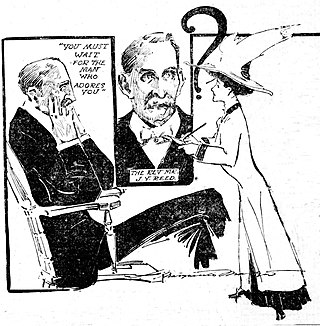
Social network analysis (SNA) is the process of investigating social structures through the use of networks and graph theory. It characterizes networked structures in terms of nodes and the ties, edges, or links that connect them. Examples of social structures commonly visualized through social network analysis include social media networks, meme spread, information circulation, friendship and acquaintance networks, peer learner networks, business networks, knowledge networks, difficult working relationships, collaboration graphs, kinship, disease transmission, and sexual relationships. These networks are often visualized through sociograms in which nodes are represented as points and ties are represented as lines. These visualizations provide a means of qualitatively assessing networks by varying the visual representation of their nodes and edges to reflect attributes of interest.
The Delphi method or Delphi technique is a structured communication technique or method, originally developed as a systematic, interactive forecasting method that relies on a panel of experts. The technique can also be adapted for use in face-to-face meetings, and is then called mini-Delphi. Delphi has been widely used for business forecasting and has certain advantages over another structured forecasting approach, prediction markets.

Qualitative research is a type of research that aims to gather and analyse non-numerical (descriptive) data in order to gain an understanding of individuals' social reality, including understanding their attitudes, beliefs, and motivation. This type of research typically involves in-depth interviews, focus groups, or observations in order to collect data that is rich in detail and context. Qualitative research is often used to explore complex phenomena or to gain insight into people's experiences and perspectives on a particular topic. It is particularly useful when researchers want to understand the meaning that people attach to their experiences or when they want to uncover the underlying reasons for people's behavior. Qualitative methods include ethnography, grounded theory, discourse analysis, and interpretative phenomenological analysis. Qualitative research methods have been used in sociology, anthropology, political science, psychology, communication studies, social work, folklore, educational research, information science and software engineering research.
Participatory design is an approach to design attempting to actively involve all stakeholders in the design process to help ensure the result meets their needs and is usable. Participatory design is an approach which is focused on processes and procedures of design and is not a design style. The term is used in a variety of fields e.g. software design, urban design, architecture, landscape architecture, product design, sustainability, graphic design, planning, and health services development as a way of creating environments that are more responsive and appropriate to their inhabitants' and users' cultural, emotional, spiritual and practical needs. It is also one approach to placemaking.

Community health refers to simple health services that are delivered by laymen outside hospitals and clinics. Community health is also the subset of public health that is taught to and practiced by clinicians as part of their normal duties. Community health volunteers and community health workers work with primary care providers to facilitate entry into, exit from and utilization of the formal health system by community members.

Visual sociology is an area of sociology concerned with the visual dimensions of social life.

Participatory action research (PAR) is an approach to action research emphasizing participation and action by members of communities affected by that research. It seeks to understand the world by trying to change it, collaboratively and following reflection. PAR emphasizes collective inquiry and experimentation grounded in experience and social history. Within a PAR process, "communities of inquiry and action evolve and address questions and issues that are significant for those who participate as co-researchers". PAR contrasts with mainstream research methods, which emphasize controlled experimentation, statistical analysis, and reproducibility of findings.
Community-based participatory research (CBPR) is an equitable approach to research in which researchers, organizations, and community members collaborate on all aspects of a research project. CBPR empowers all stakeholders to offer their expertise and partake in the decision-making process. CBPR projects aim to increase the body of knowledge and the public's awareness of a given phenomenon and apply that knowledge to create social and political interventions that will benefit the community. CBPR projects range in their approaches to community engagement. Some practitioners are less inclusive of community members in the decision-making processes, whereas others empower community members to direct of the goals of the project.
Public engagement or public participation is a term that has recently been used to describe "the practice of involving members of the public in the agenda-setting, decision-making, and policy-forming activities of organizations/institutions responsible for policy development." It is focused on the participatory actions of the public to aid in policy making based in their values.

Mental health literacy has been defined as "knowledge and beliefs about mental disorders which aid their recognition, management and prevention. Mental health literacy includes the ability to recognize specific disorders; knowing how to seek mental health information; knowledge of risk factors and causes, of self-treatments, and of professional help available; and attitudes that promote recognition and appropriate help-seeking". The concept of mental health literacy was derived from health literacy, which aims to increase patient knowledge about physical health, illnesses, and treatments.
Peer education is an approach to health promotion, in which community members are supported to promote health-enhancing change among their peers. Peer education is the teaching or sharing of health information, values and behavior in educating others who may share similar social backgrounds or life experiences.
Patient participation is a trend that arose in answer to medical paternalism. Informed consent is a process where patients make decisions informed by the advice of medical professionals.
Participatory evaluation is an approach to program evaluation. It provides for the active involvement of stakeholder in the program: providers, partners, beneficiaries, and any other interested parties. All involved decide how to frame the questions used to evaluate the program, and all decide how to measure outcomes and impact. It is often used in international development.
Photo-elicitation is a method of interview used in research which incorporates photographs in the interviews. The method is participatory-oriented and is used in different research areas such as visual sociology, marketing research, and public health. In the method, images are used to prompt and guide in-depth interviews and to evoke reactions from the interview participant. The types of images used include photographs, video, paintings, cartoons, graffiti, and advertising, among others. Either the interviewer or the subject may provide the images.
Visual research is a qualitative research methodology that relies on artistic mediums to produce and represent knowledge. These artistic mediums include film, photography, drawings, paintings, and sculptures. The artistic mediums provide a rich source of information that has the ability to capture reality. They also reveal information about what the medium captures, but the artist or the creator behind the medium. Using photography as an example, the photographs taken illustrate reality and give information about the photographer through the angle, the focus of the image, and the moment in which the picture was taken. Nevertheless, some argue that visual research is not comparable to traditional methodology.

An interview in qualitative research is a conversation where questions are asked to elicit information. The interviewer is usually a professional or paid researcher, sometimes trained, who poses questions to the interviewee, in an alternating series of usually brief questions and answers. They can be contrasted with focus groups in which an interviewer questions a group of people and observes the resulting conversation between interviewees, or surveys which are more anonymous and limit respondents to a range of predetermined answer choices. In addition, there are special considerations when interviewing children. In phenomenological or ethnographic research, interviews are used to uncover the meanings of central themes in the life world of the subjects from their own point of view.

Art-based research is a mode of formal qualitative inquiry that uses artistic processes in order to understand and articulate the subjectivity of human experience.
Meredith Minkler is an American public health researcher who is emeritus Professor at the University of California, Berkeley. She is known for her work on community-based participatory research and its use in public policy, criminal justice reform and democratizing access to food.

Video Data Analysis (VDA) is a curated multi-disciplinary collection of tools, techniques, and quality criteria intended for analyzing the content of visuals to study driving dynamics of social behavior and events in real-life settings. It often uses visual data in combination with other data types. VDA is employed across the social sciences such as sociology, psychology, criminology, business research, and education research.

Nicole Brown is an Austrian and British writer and academic whose expertise lies with social research practice. She focuses on the development and pragmatics of research methods and approaches for data analysis as well as dissemination.








